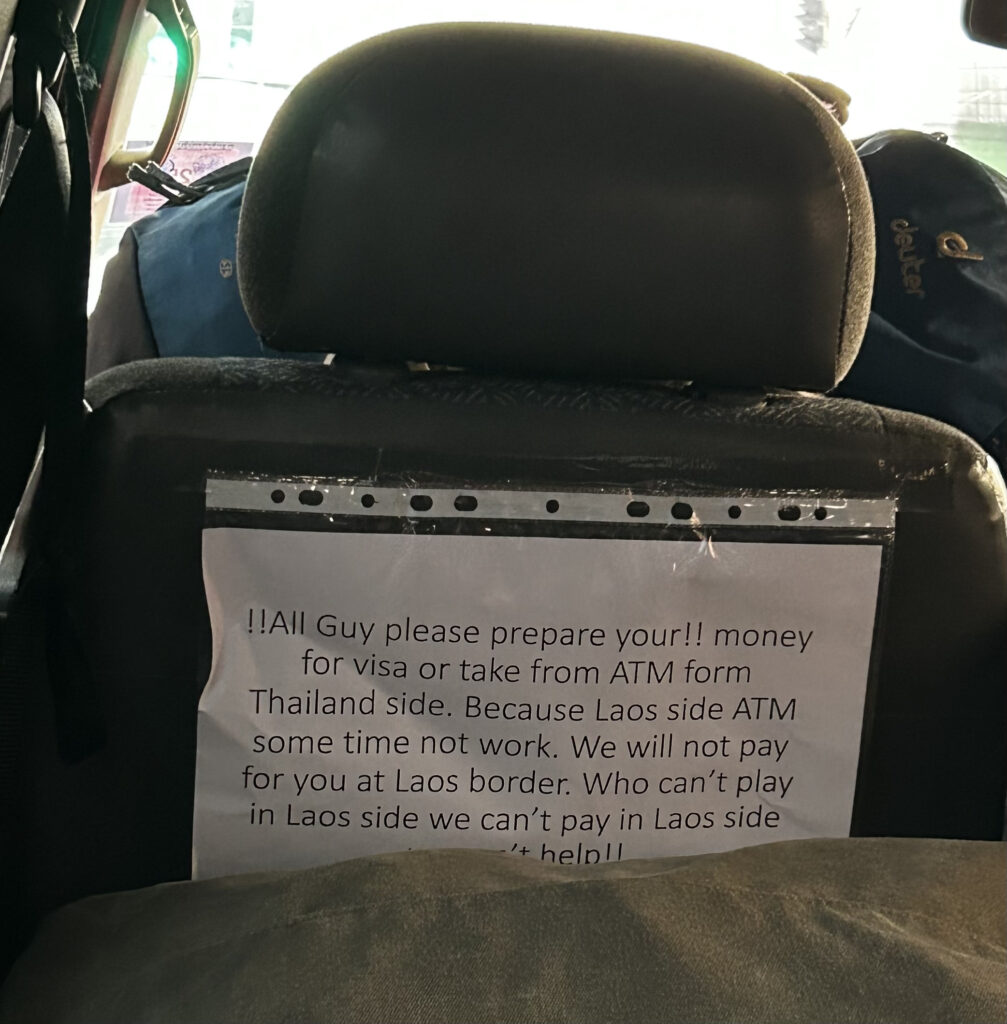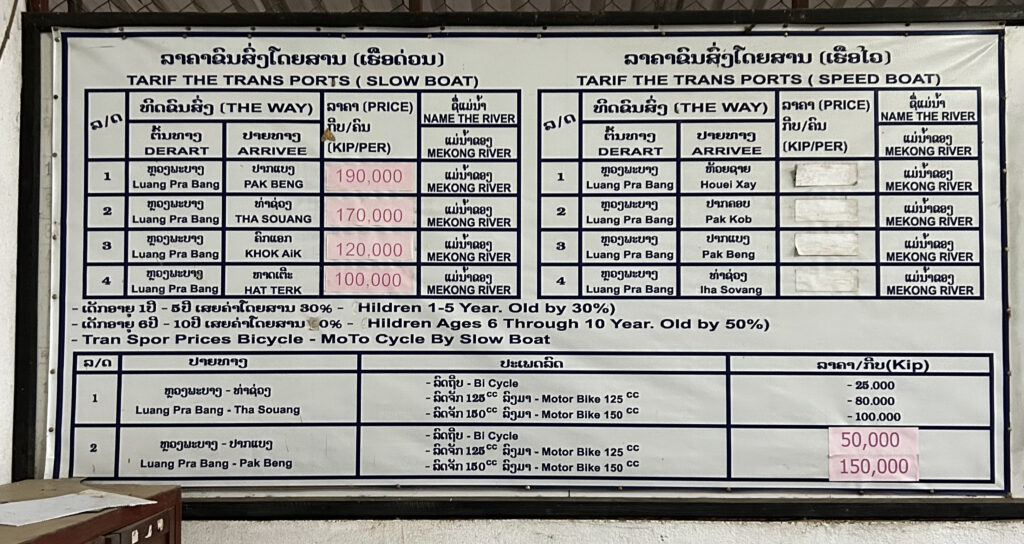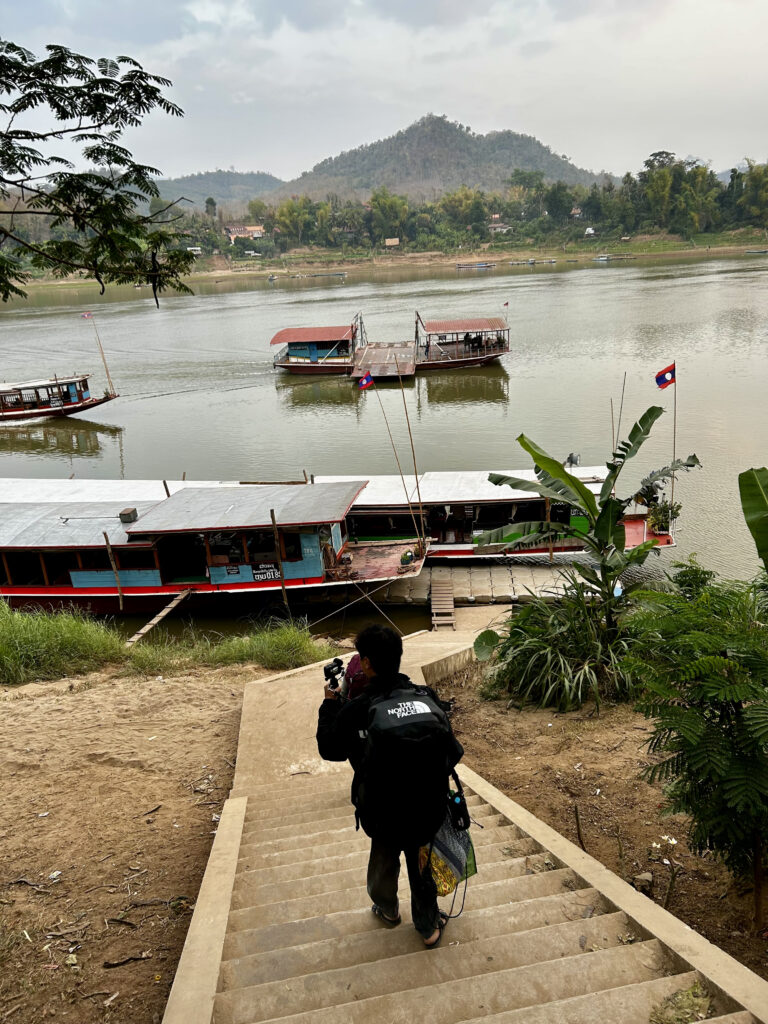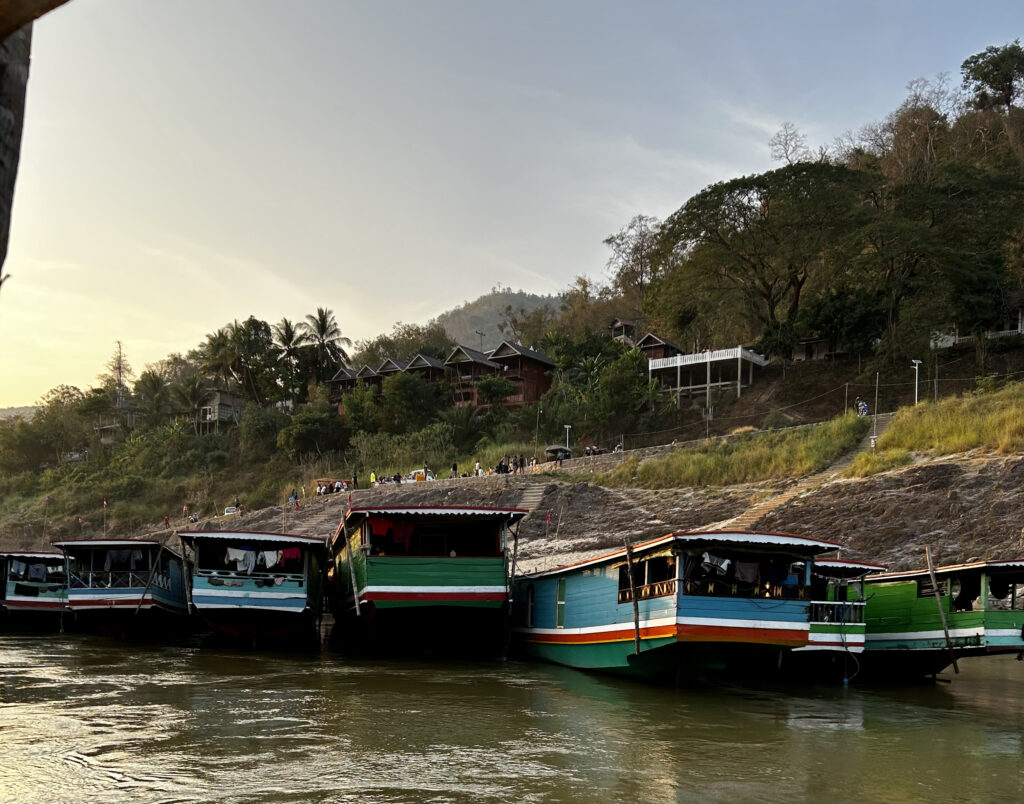The iconic slow boat down the Mekong River from the Thai-Lao border town of Huay Xay to the picturesque old capital of Laos, Luang Prabang, is a staple in a budget backpacker’s journey to Laos. However, is this journey still worthwhile in 2024?
It started as a great alternative to the long bus ride to Laos or a great way to save money on flights. As it is a local slow boat, it was also a fantastic way to get a glimpse of the local life on the banks of the Mekong. Nonetheless, with the popularity of this means of transport among tourists, the demographic of the passengers is mainly foreigners.

Photo: On the slow boat from Huay Xay to Pak Beng in January 2023
We have taken the slow boat twice, both times in January/February, which is during the dry season and consequently the high season. Last year (2023) we took the more popular direction of going from Huay Xay to Luang Prabang and this year we did it the other way around. We had vastly different experiences on these two journeys. The way from Huay Xay to Luang Prabang is significantly more crowded and seats in the slow boat were filled up. But since the boats are full there is a bigger chance to meet new friends. The other way, however, is significantly less crowded, and in our case, everyone on the boat had 2 to 3 seats all to themselves. This meant that it was comfortable to lie down and take a nap or read a book during the long boat ride. Nonetheless, since everyone was a bit more spread out, it might be more difficult to make friends.
I would recommend taking the boat from Luang Prabang to Huay Xay and not the other way around. This is because the journey was far more relaxing and less tiring than our experience of sitting in the engine room of an overbooked boat the previous year.
Now let’s go into the details of the journey!
Huay Xay to Luang Prabang
There are options for packages from Chiang Mai or Chiang Rai to the Lao border and all the way to the slow boat pier in Huay Xay. You can also make the journey yourself using public transportation. We opted to book the journey as a package from the hostel we were staying at in Chiang Rai. The tour company picked us up straight from our hostel in a minivan early in the morning and took us to the Lao border. This van ride took a few hours.

Photo: Sign in the minivan reminding passengers to have enough cash on them for the visa fee while entering Laos
All was well until we got to the border. Then the organizer of the tour very strongly advised us not to exchange money to Lao Kip at the border since he claimed that we would get a better exchange rate at their office in Huay Xay. I believed this at the time, since exchange rates at borders can be quite bad. Straight after we crossed the border we were taken in a tuk-tuk to the office of the tour company. At this office, they were trying to sell us everything from beer and snacks for the boat ride to sim cards and hostel bookings for Pak Beng. All of this, including the exchange rate to Lao Kip, was vastly overpriced. Nonetheless, there was nothing at walking distance from the office so we had no choice but to exchange some money and buy some snacks for the journey. The worst part of this tour was that they took us to the boat at the very last minute so that we wouldn’t have time to buy anything from the vendors near the pier (although we did rush to buy a few cheaper beers from a small vendor next to the pier). Since we got onto the boat so late, we were the last ones to get on and could not get seats and had to sit on the floor at the back of the boat in the engine room. This would not have been a big problem, except the engine was very loud and there was a bit of a smell.

Photo: Beer and sandwiches on the boat
During the dry season, the boats can get very full, and even if your ticket has a “seat number” those numbers are not followed at all so it is best to arrive at the boat early enough to get a good seat to secure good views on the way. Also when choosing a seat it’s good to note that the engine is very loud and thus the back of the boat can get quite unbearable during the long journey.
In the late afternoon of the first day, you will arrive in Pak Beng, which is a small town on the bank of the Mekong River, halfway between Huay Xay and Luang Prabang. It is important to note that since it is a small town, there are only two ATMs in Pak Beng which are known to run out of money once in a while. The last time we were there only one of the ATMs had money.

Photo: queue for the ATM in Pak Beng
On the next day of the journey from Pak Beng to Luang Prabang we learned from the previous day and made sure to be on the boat early enough to secure good seats near the front of the boat. Also note that the slow boat pier in Luang Prabang is far from the city and you will have to take a tuk-tuk, which has a set price per person, which at the time was 20k Lao Kip. Thus, it’s good to make sure that you have enough cash on you for the ride to the city.
All in all we were very disappointed with the service of the company that the hostel booked us with. And if I were to do this trip again in this direction, I would recommend arriving in Huay Xay the day before taking the boat.
Luang Prabang to Huay Xay and then Thailand
Since we were not happy with the tour company we went with last year, this year we decided to embark on the journey on our own. The prices of the slow boat have been raised since the start of 2024, so do note that all of the prices have gone up compared to previous information that can be found online. If you purchase the ticket directly from the pier in Luang Prabang it costs 190k Kip (8.5 USD) to Pak Beng and 200k Kip (9 USD) the next day to Huay Xay. In addition to the price of the boat tickets we had to take a tuk-tuk to the pier was 150k Kip (7.8 USD) for 3 people. So all in all the tuktuk and boat tickets cost 440k Kip per person. Booking through a hostel or a travel agent cost 500k Kip (22.5 USD)this year which is not a big difference so it may not be worth it to do this on your own.

Photo: Ticket pricing as of February 2024
We bought the first day’s ticket to from the counter at the pier in Luang Prabang. We arrived at the pier a bit after 7 am because we were a bit worried about finding a tuk-tuk and other moving parts that might go wrong in the morning so we decided to play it safe and leave very early. But it’s not really necessary to arrive at the pier that early, it’s just good to be there before the packed tuk-tuks arrive there at 8am so that you can get a good seat.

Photo: Getting on the boat in Luang Prabang
The boat ride is quite smooth and pleasant. It’s perfect for reading a book, enjoying sandwiches and other snacks that you can bring with you. And drinking some Beerlao! You can also buy some cup noodles and more beer from the small vendor on the boat, but the price is more expensive than if you buy it from a shop beforehand.

Photo: Arriving in Pak Beng
A big surprise for us this year was the price of the accommodation in Pak Beng. All of the information I had found online in advance, as well as our own experience last year, suggested that it is fine to show up to Pak Beng without a booking for accommodation and that you can find a bed for around 5 USD. This year luckily we had booked in advance although it was more expensive than expected. The prices were around 16 USD for dorm beds and 18 USD or more for private rooms. I also saw some backpackers walking around desperately trying to find accommodation as many hostels had signs outside that they were fully booked. Nonetheless, I heard from a friend who traveled this route in May, the beginning of the rainy season, this year and she did not book anything in advance and got a decent dorm bed for 5 USD. So my word of warning may only apply to the high season.
Arriving in Huay Xay
Tuk-tuks in Huay Xay seem to have a set price of 50k Kip (2.2 USD) per person for all journeys regardless of how long it is. The slow boat arrives after 5 pm and the border crossing seems to be open at that time but at an additional cost which needs to be paid to both sides of immigration and the bus across the Friendship Bridge costs a bit more as well. At that time the only means of transport to Chiang Rai or elsewhere are private cars/vans. A car costs 1800 Baht (51 USD) to Chiang Rai and a van costs more than that. We opted to stay in Huay Xay for the night and the town was surprisingly lively and pleasant. There were a few nice restaurants and the prices in general were cheaper than in Pak Beng.
The next morning, we began our journey across the border. We first took a tuk-tuk to the international bus station of Huay Xay as we were under the impression that there would be some busses from to Chiang Rai (and according to the schedule there should be a bus at 9:30 and 16:30 but we were hoping that those were just the first and last bus since we assumed it was a common destination from Huay Xay) nonetheless, at the bus station we were told that there are no busses to Chiang Rai and we were advised to go to the border. Now the haggling for tuk-tuks started again since they insisted on charging us the same 50k (2.2 USD) per person which is the price for the significantly longer trip from the slow boat pier to the border. We managed to get a tuk-tuk for 100k (4.5 USD) for three people. The border crossing went smoothly.
Right after the border, there is a desk where they sell tuk-tuk tickets to Chiang Khong bus station. The tickets are a set price of 60 Baht (1.7 USD) per person. The tuk-tuk driver made sure that we got to the right bus station as the bus to Chiang Mai and the local bus to Chiang Rai leave from different places on the opposite side of the same street. We took a very local bus to Chiang Rai which only cost 90 Baht (2.5 USD) per person but took around 2,5 hours. The bus didn’t have AC and the windows and doors were open the whole way so there was air circulation but also a lot of dust. The bus left a few minutes after we arrived at the station, which was very convenient for us. And I’ve heard that these buses run every half an hour. Our friend took the bus from Chiang Khong to Chiang Mai and it left at noon and took over six hours.
I hope this was helpful and if you have any questions, feel free to leave a comment!
Thank you for reading and safe travels!
-P

